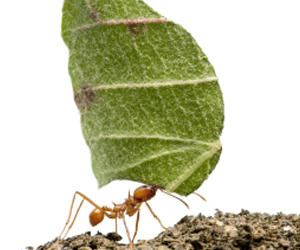Subduing the Hive Mind: An enemy’s enemy could become an unlikely friend
Posted on July 30, 2014 by Jon Fuhrmann
Leafcutter ants form some of the biggest, most remarkable animal societies on Earth, living in sprawling colonies of up to 8 million individuals. These ants harvest more greenery in South American rainforests than any other animal, consuming almost 20% of the annual vegetation growth. Their voracious appetite also makes them a significant agricultural pest.

At the University of Costa Rica, Dr Adrián Pinto-Tomás and his colleagues are looking for ways to minimise the impact of leafcutter ants on agriculture in a sustainable manner, while ensuring that the region’s unique ecosystems remain balanced.
Leafcutter ants cultivate a fungus, Leucoagaricus gongylophorus, in “gardens” within their colonies; the ants feed the leaves they cut to the fungus, which is the colony’s sole food source. Leafcutter ants thus form sophisticated farming societies in symbiosis with the fungal cultivar. Each individual ant is adapted in terms of size and physiology to its specific role in contributing to the success of the fungal garden. Soldiers, for example, are the largest ants, with pincers powerful enough to bite through leather boots. Smaller ants may forage for leaves outside the colony, work as gardeners around the fungal cultivar or feed and clean the queen, the only ant in the entire colony capable of laying eggs and producing offspring.
Leafcutter ant colonies derive their ability to overcome adversity from their astonishing society structure and co-operation, and their strength in numbers. There is currently no easy way for farmers to get rid of colonies effectively. Instead, vast amounts of broad-spectrum insecticides are pumped into the ground in an attempt to permeate entire ant colonies, which can measure almost 100 feet across. This has an adverse impact on the wider environment, which both farmers and governments are keen to avoid. This is where Dr Pinto-Tomás and his lab come in: they have taken an important step towards developing a sustainable biocontrol method for leafcutter ants.
Since the fungal gardens are located in warm, damp underground chambers within the ant colony, they are at risk of being invaded by a range of other organisms and pathogens harmful to the gardens or the ants themselves. The ants have evolved defences against this constant threat, including sanitising behaviour patterns and “quality checks” of leaf material on its way to the fungal garden. In their recent study, published in the journal Microbiology, Pinto-Tomás and his team have studied the one intruder that regularly infests and destroys fungal gardens: a parasitic fungus named Escovopsis.
Escovopsis has evolved in parallel with leafcutter ants ever since the ants domesticated their fungal cultivar, L. gongylophorus, some 50 million years ago. Since then, Escovopsis and the ants have been locked in a so-called “evolutionary arms race”, with both sides continuously evolving traits to outcompete the other. While Escovopsis is currently present in many fungal gardens, the small leafcutter ant workers in charge of maintaining the garden can usually keep the infestation under control.
Dr Pinto-Tomás believes that with a little “helping hand”, Escovopsis could destroy fungal gardens much more successfully, forming the basis for a highly targeted ant control method. Escovopsis is not known to infect any organisms other than L. gongylophorus, so it would not harm other organisms in the way broad-spectrum insecticides do.
In a series of microbiological tests, the researchers showed that L. gongylophorus fungi found in colonies across Costa Rica are based on very similar genetic material. The Escovopsis strains infecting the fungal gardens exhibit much higher genetic diversity. What’s more, the most successful, aggressive strains of Escovopsis share important genetic similarities. The team hope to study these similarities more closely in order to understand how to make the parasite more effective. Their ultimate aim is to produce Escovopsis strains that can attack fungal gardens more “stealthily”, so that the ants in charge of maintaining the garden do not notice the infestation until it is too late.
The larger-scale implications of removing a large proportion of leafcutter ants from farmland ecosystems are yet to be researched in detail. However, it is worth noting that it is human deforestation that caused the number of leafcutter ant colonies to increase to the point where they became a significant pest. Research by a German-Brazilian team showedthat leafcutter ant colonies living at the edges of forested areas have much smaller foraging areas while consuming the same amount of leaf material compared to colonies in the interior of forested areas. This means that the same land area supports more colonies at the forest edge, causing more intense defoliation. This effect is even more pronounced on monoculture farmland. Compared to an average of one colony per hectare in forest interiors, densities of up to 100 colonies per hectare have been reported from a coffee monoculture in Costa Rica.
Human land use change has produced environments across Costa Rica in which leafcutter ants thrive to the extent that they become an agricultural pest. A safe, highly targeted way of dealing with this pest would be a significant step up from pumping broad-spectrum antibiotics into farmland soils, and would contribute to the health of both the people and the environment of Costa Rica.
Elizondo Wallace, D., Vargas Asensio, J., & Pinto Tomas, A. (2014). Correlation between virulence and genetic structure of Escovopsis strains from leaf cutting ant colonies in Costa Rica Microbiology DOI: 10.1099/mic.0.073593-0
